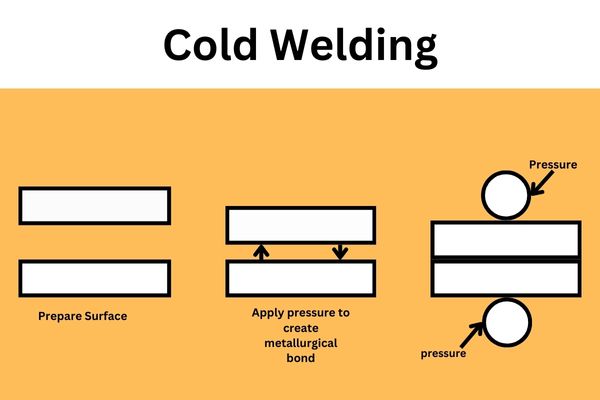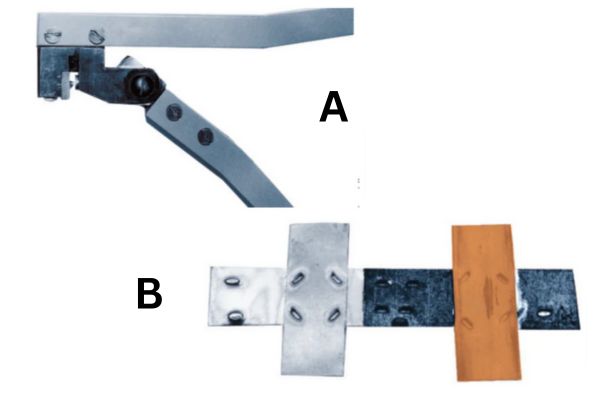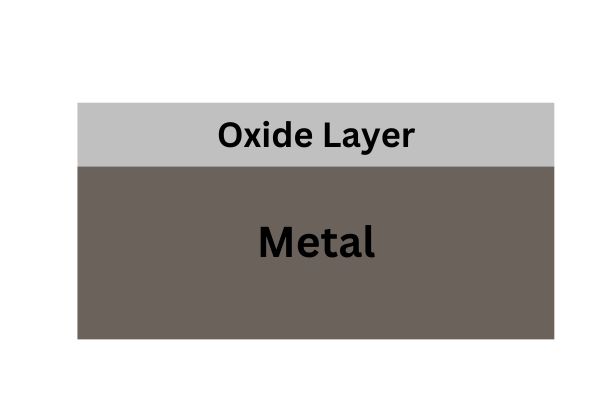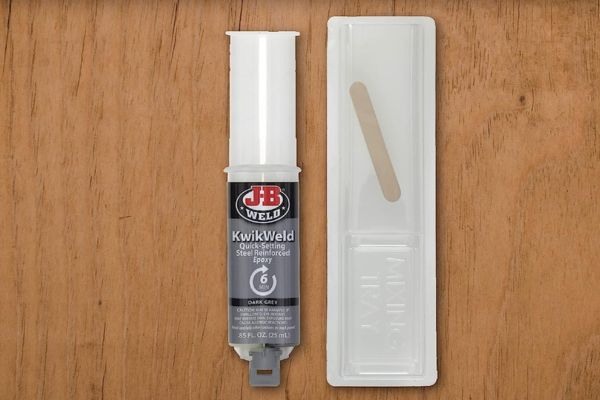When we hear about welding, what comes to our mind first is the flames, electric arc and weld seam. But if I tell you that there are a type of welding which doesn’t require any flame, arc or heat to join metals! I know you got surprised hearing that. But it really exists and in this post I will describe the method in details.
So lets talk about a welding technique called “Cold welding“.
What Is Cold Welding

Cold welding is also called a solid state welding. It is a welding technique where no heat or fusion is used. In Fact no arc is created and no flame is applied on the metal in this process. Instead, only pressure is used while cold welding. The technique doesn’t liquify or molten the parent metal to fuse together too.
So we can summarize that cold welding is a special type of welding technique that uses no electric arc, heat, fusion on the metal but joins the metal together by applying pressure through a specially designed cold welding machine to get the bond.
History Of Cold Welding
In 1724 a scientist named Reverend John Theophilus Desaguliers first used the cold welding technique scientifically. He used two lead balls, holding and twisting with pressure, to test the bonding potentiality. This is the time when everyone came to know about cold welding.
But he is not the inventor of cold welding technique. Rather, the history of cold welding goes back to the bronze age. Few archaeologists have found some tools in 1940 and after testing it was uncovered that the tools were from the Bronze age.
They presumed the tools were made by using cold welding techniques as the aesthetic and strength of the tools were proving it to be true.
How Does It Work
We already know that cold welding is bonding of two metals without applying any heat and melting the metals to join to each other. But a question arises how it works? How do two metals join without fusion?

The answer is in the metallurgy of metals. We know that all metal contains an oxide layer on them. This oxide layer prevents atoms of the materials from moving and pressing together. Thus metals can’t get any bonds just by applying pressure.
If we remove the oxide layer from the metal and apply a significant amount of pressure, then the metal pieces would come closer to each other making Nano-distance almost irrelevant. This situation makes the atoms jump from one metal to another and thus the two pieces of metal get attached to each other. That is the science behind cold weld.
The bond by cold welding is so realistic that even the joint line can’t be determined with bare eyes. Following image depicts the cold welding tool and cold weld between mild steel, aluminum and copper.

Image source: Welding: Principles and Applications book 8th ed. by Larry Jeffus, page 736.
How Can We Remove Oxide Layer From Metal
If you don’t get the oxide layer peeled off then you won’t be able to cold weld the metal pieces. To remove the oxide layer you can either use an abrasive method like wire brushing the metal surface or use degreasing to get rid of the oxide. You can also use Alkaline or acid pickling to remove the oxide. You can take the sanding paper of 100-200 grit size into consideration too.

A famous physicist Richard Feynman, said in his book “” that
“The reason for this unexpected behavior is that when the atoms in contact are all of the same kind, there is no way for the atoms to “know” that they are in different pieces of copper. When there are other atoms, in the oxides and greases and more complicated thin surface layers of contaminants in between, the atoms “know” when they are not on the same part.“
The Feynman Lectures on Physics
It summarizes that to get a quality and strong cold weld,you must clean the metal well. The cleaner the metal the better.
Note: Remember that metals contain not only the oxide layer on them but also oils or grease. If you use abrasives to remove oxide before cleaning the oil or other impurities, they may get pushed inside the metal due to the friction. Then cold welding would not work. So clean the oil and other contaminants first and then go for removing the oxide layer.
Application Of Cold Welding
- Cold welding generally is used in projects where arc welding can be dangerous. For example, for laying underground wire, cold welding is used to join the wires. Because arc welding or any kind of electric arc can cause flames which in turn would ruin the wiring system.
- This method is used in applications where there is a risk of explosion. For example: to seal containers containing explosives or any chemical elements, cold welding is used. It reduces the risk of explosion.
- Cold welding is used in space also. Because in space there is no oxygen so no use of arc welding as it won’t produce flame.
- Cold welding is used in aerospace, automobiles and dentistry too.
Advantages
There are many advantages of cold welding. They are:
- You don’t need an expensive welder machine to cold weld metal
- You don’t need to buy welding accessories like filler metal, electrodes, gas cylinder, welding torch and electrode holder for cold welding which is good for a thrifty person
- As you don’t need to apply heat to fuse the metal in cold welding, No HAZ (Heat affected area) is created. So there will be no mechanical or chemical change in the metal property.
- You will get clean and a strong weld with cold welding. There will be no spatter, no slags, no wastages of metal that is inevitable in other arc welding techniques.
- You can join dissimilar metals easily with cold welding. For example some series of aluminum like 7xxx and 2xxx series are non-weldable. You can join these types of metal with cold welding techniques.
- Cold welding techniques don’t need any special environment or well ventilated area for perfectly doing its job. You can cold weld anywhere you want. Just make sure the metal surface should be clean and dust free.
Disadvantages
Cold welding is an easy and affordable technique. Despite this, it has some dis-advantages. Let’s check them out-
- You need to clean the parent metal before starting cold welding. If you don’t then you won’t get a strong bond.
- You need to clean the oxide from the metal surface too which is expensive and time consuming at a time
- You can’t cold weld all types of metal. The metal to be cold welded must be ductile and carbon free.
- You may face difficulties in cold welding on uneven metal surfaces. That means you must make the surface of the parent metal flat or smooth to get a quality cold weld.
Types Of Cold Weld
There are actually no types of cold welding. There are few methods that work similar to cold welding. That’s why few people mistakenly think tig cold welding, cold metal transfer and jb weld as cold welding.
1. Tig Cold Welding
Tungsten Inert Gas (TIG) cold welding is a precise and sophisticated welding process.
This approach diverges from the concept of cold welding. It utilizes a non-consumable tungsten electrode to produce welds with minimal heat input. This is accomplished by applying a brief arc spot for a fraction of a second.
The temperature remains minimal, and heat dissipates due to the high conductivity of metals like aluminum. This method minimizes the risk of distortion and heat-affected zone, making it particularly suitable for delicate or heat-sensitive materials.
TIG cold welding is commonly employed in industries such as aerospace and electronics, where precise control over the welding process is crucial for maintaining the integrity of intricate components and ensuring high-quality welds. Also it is extremely used for joining thin metal sheets and wires together.
2. Cold Metal Transfer
Cold Metal Transfer (CMT) is an advanced welding process that operates on the principle of controlled metal droplet transfer, minimizing heat input and reducing the risk of thermal distortion. It is like fusion welding as an arc is employed in the method.
Unlike traditional welding methods, CMT uses a precisely controlled short circuit to transfer small droplets of metal from the electrode to the workpiece. This controlled and low-heat process is particularly well-suited for welding thin materials and dissimilar metals.
However, this process requires heat input approximately 90% less than the other conventional fusion welding approaches. This is why the method is mislabeled as cold welding. But it is not a cold welding. In fact there are huge differences between cold welding and CMT methods.
JB Weld
Jb weld actually is a brand name. The brand produces epoxies for joining metal, plastic, rubber etc. JB weld is an adhesive that is applied between two pieces of metals and clamped for a while to join the pieces together.

Though it joins two metals, it doesn’t provide a strong bond as fusion welding or cold welding. People mislabeled it as cold welding as the both methods do not use flame, electric arc or heat to melt and fuse the metals.
Check The Strength Of The Cold Weld In The Video
FAQ (Frequently Asked Questions)
1. What metals can be cold welded
You can cold weld any metal that has a specific level of ductility. No-ferrous metal like aluminum 7xxx series, brass alloy with 70/30 ratio, zinc, silver, silver alloy and gold can be cold welded.
Also metals that are non-weldable, can also be welded using cold weld technique. With a high pressure you can cold weld stainless steel too but you can’t cold weld metals having carbon.
2. Is cold welding strong
Cold weld can be as strong as other welding techniques. In some cases it can out-perform the arc welding process. You just need to make sure all requirements are fulfilled for cold weld, the metal chosen has enough ductility and it is free from carbon.
Also rush off the oxide from the metal to get a strong cold weld.
Last Words
Cold welding has been used since the bronze age but got recognition in the 16th century. It is a special type of welding technique that uses no heat to join metal. This feature makes it one of the prominent welding techniques in the world.
Related Article
